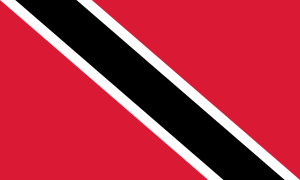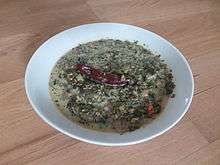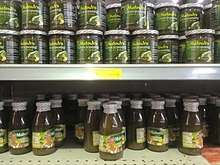Trinidad and Tobago cuisine
| Part of a series on the |
| Culture of Trinidad and Tobago |
|---|
 |
| History |
| People |
| Cuisine |
|
|
Music and performing arts |
|
Media |
| Sport |
|

Trinidad and Tobago cuisine is indicative of the blends of African, Amerinidian, British, Creole, French, Indian and Spanish influences
Main meals
Breakfast dishes

Popular Breakfast Foods- Sada Roti which is usually served with: Fried or Curry Bodi (long beans), Fried or Curry Bhindhi (okra), Curry Sem, Curry Saijan (moringa drumstick), Fried or Curry Kareli (bittermelon), Baigan Choka (roasted eggplant), Damadol Choka (roasted tomatoes), Kohda Tarkari (pumpkin simmered in garlic, onion, cumin), Aloo Choka (roasted potatoes with onion and garlic), Fried Aloo (potatoes with spices fried in oil), and Fried plantains. Some other breakfast foods are Accra (fried salt fish and flour), Stew Chicken liver or gizzard, and the popular bake and shark. Hashed browns with Vienna sausages and eggs is a breakfast combination made almost everyday throughout towns such as Diego Martin, Westmoorings and Valsayn.
Fried bake (a fried dough unleavened bread) is usually served with saltfish (dried and salted cod), sardine, corn or smoke herring (smoked, salted, and dried fish), buljol (saltfish with fresh sweet peppers, tomatoes, cucumbers and sometimes boiled eggs), bacon, shark, fried plantain, stew chicken, or Corned beef with onions and tomatoes.
Coconut bake (coconut bread) is usually served with fried accra (saltfish fritters), black pudding, butter, cheese paste (a mixture of cheese, mustard, grated onion, and mayo), tannia cakes (fried dasheen cake), and boiled yuca with butter, fried plantain.
Hot Milk Drinks:
Farine with powdered milk (farine-ground and parched cassava)
- Chocolate tea (chocolate made from homemade cocoa balls)
Lunch and dinner

A very popular and nationally well known dish with distinctly African roots is callaloo, a creamy and spicy side dish made of dasheen or Taro leaves, okra known locally as okro or bhindhi, crab or pigtails, thyme, pumpkin, pimento, onions, coconut milk and shado beni (from "Chardon Bénit,"French thistle or Fitweed) or bandhaniya (Hindi ban dhaniya, "closed cilantro") or shadon beni or culantro. Callaloo is often served with cornmeal coo coo, plantain, cassava, sweet potatoes, dumplings and curried crab.
Pelau, a rice-based dish, is a very popular dish in Trinidad and Tobago, as well as stewed chicken, breadfruit oil down, macaroni pie, ox-tails, among many others. One of the most popular Trinidadian dishes is curried duck served with either roti or rice. Local curried duck cooking competitions are often held with multiple variations being created. A simple dish to make, but difficult to master, curried Muscovy is regarded as a delicacy which can be served at all times.
Trinidad and Tobago dishes are often curried, stewed, or barbecued, An array of fish and seafood can be bought at local merchants throughout Trinidad and Tobago, such as flying fish, king fish, carite, prawns, sapatay, red fish, shrimp, bonito, lobster, conch and crab, tilapia and seasonal cascadura. Tobagonian food is dominated by a wide selection of seafood dishes, most notably, curried crab and dumplings, and Tobago is also known for its sumptuously prepared provisions, soups and stews, also known as blue food across the country. "Fish broth" a soup made in the style of Bouillabaisse is quite popular as a main dish or as a side. Tobago is particularly famous for its "curried crab and dumplings".
A popular Trini dish is macaroni pie, a macaroni pasta bake, with eggs and cheese, and a variety of other potential ingredients that can change according to the recipe being used.
Another local dish is the rare delicacy cascadu (cascadura), which is a small, freshwater fish. The fish is curried and served with lagoon rice and cassava and yams. There is a local legend in Trinidad that s/he who eats cascadu will return to Trinidad to end their days.[1] Also a special type of West Indian spaghetti dish is made in the towns of Chaguanas, Couva and some parts of San Fernando. It is made by using durum semolina, scorpion peppers, pasta sauce and a hint of garlic sauce. Everything is sauteed in a sauce pan until all the fluid dries. It is then served with salt dashed on top with some rosemary and parsley.
Condiments

Trinidadians accompany their meals with various condiments; these can include pepper sauces, chutneys and pickles and are often homemade. Pepper sauces are made by using habanero or other hot peppers, either minced or chopped and other spices. It can sometimes include lime or lemon as well as other vegetables, and come in many variations and flavors. The murtanie (mother-in-law) is another popular condiment which is a coarsely chopped spicy medley of habaneros, carrots, kareli (bitter melon) and other spices. Chutneys are popular as well and often include mango, tamarind, cucumber, bandhaniya, tomato, and coconut. There are a variety of popular pickles known locally as Achar which are commonly used. Kuchela a grated spicy version, usually made from mango but sometimes made from pommecythère, the Mango version being most popular. Other version of Achars are made from mango, pommecythère, tamarind, amla, lemon, lime, and chulta. Chow is also a popular condiment, as is green seasoning, a cold sauce based on cilantro. It is made by using the fruit of choice, culantro (shado beni, bandhaniya), pepper (powdered, sauce or natural form), garlic, vinegar, and salt. Traditionally, the most popular fruits for chow have been mangoes, pommeracs, pommecythère, cucumbers, tomatoes, cherries, pineapples, green apples, pears, and plums. The fruits are basically "seasoned" by the rest of the base ingredients and the larger fruits are usually cut up into bit sized pieces.
Street foods
.jpg)
Street foods: Popular freshly prepared street foods include Indian delicacies like doubles, saheena, baiganee, aloo pie, pholourie, kachori, pakora, samosa, roti wrap (all which are famous in Debe). Some more are bake and shark (particularly at Maracas Beach, a popular beach on the North coast), wontons, corn soup, geera (cumin) pork, geera chicken, kebeabs, gyros, pasteles, raw oysters (usually sold at stalls where there is a lighted kerosene torch or flambeau, with a spicy sweet/hot sauce mainly with cilantro or bandhaniya aka shadon beni aka culantro), fish pies, macaroni pies, cheese pies, beef pies (many Trinidadian neighbourhoods boast a local pie-man), and pows (Cantonese pao-tzu < baaozi, steamed wrapped roll with savoury or sweet filling – steamed buns filled with meat, typically char siu pork). Sausage rolls are also eaten as midday snacks and are available at stands usually found along the nation's streets.
A popular street side favourite, before the consumption of alcohol, is souse (made from pig, cow or chicken feet seasoned with onion, garlic, salt, pimento and scotch bonnet peppers, lemon and chadon beni), served warm (mostly) or slightly chilled (room temperature). It is also rumoured to be a cure to hangovers. When in season, roast and boiled corn on the cob can be found any time day or night.
On festive occasions (Carnival, Borough Day and most public holidays), street foods also include wild meat such as deer, iguana, manicou (opossum), tatou (armadillo), and agouti, to name a few. These are prepared either as a creole or curry dish, and served with a wide choice of local pepper sauces.
Cold Street Snacks: On hot days, locals enjoy ice cream, snow cones (served in various colours, flavours and shapes, often sweetened with condensed milk), ice pops, kulfi, freezies, sucker bag, coconut slushies, coconut water, and fresh coconut jelly.
Festival foods
Special Christmas and Easter foods include pastelles (called hallaca in Venezuela where they originated), garlic pork (carne vinha-d'alhos, a Portuguese dish), boiled or baked ham, turkey, pigeon peas, fruitcake, blackcake, ginger beer, ponche crema, egg nog, and sorrel.
Special Diwali, Navratri, Phagwah, Ram Navami, Krishna Janmashtami, Mahashivratri, Vasant Panchami, Hanuman Jayanti, Ganesh Chaturthi and other Hindu festivals foods include mohan bhog (parsad), lapsi and suhari, burfi, khurma, gulab jamoon, pera, rasgulla, rasmalai, batasa, gujiya, roat, kheer, laddu, jalebi, halwa, roti (dalpuri, puri, sada roti, dosti roti, paratha, aloo paratha), curry aam, dal bhat, kharhi, murtanie (Mother-in-law), channa aur aloo (curried chickpeas and potatoes), curry katahar or chataigne (curry breadnut), and other vegetarian curries, tarkaries, and Indian dishes and desserts.
Special Eid, Hosay, and other Muslim festival foods include curry goat, sewiyan, burfi, rasgulla, sirni, halwa, and baklawa.
Desserts
The popular local desserts are usually extremely sweet. Local snacks include cassava or coconut pone and stewed guavas, sweetbread, paw paw balls, tamarind balls, bene balls (sticks or cakes), toolum, guava cheese (guava paste), jub jub and sugar cakes, nut cake, chilli bibi and brown sugar fudge. Local chocolatiers and confectioners manufacture several different types of sweet treats. Indian delicacies like kheer, sewiyan, paysam, rabri, khurma, gulab jamoon, roat, chum chum, laddu, jalebi, jhangri, halwa, mohan bhog (parsad), sirni, baklawa, malpua, lapsi and suhari, thekua, rasgula, gulgula, rasmalai, pera, kulfi, gur, lassi, petha, modak, gujiya, batasa, and burfi are also popular.
Beverages

There are many different popular beverages in Trinidad. These include, various sweet drinks [sodas] (Chubby's, Busta, LLB (Lemon Lime and Bitters), Solo, Peardrax, Coca-Cola, Fanta, Pepsi, Dr. Pepper, and Sprite[2]), and also Malta, Smalta, Shandy, citrus juice, ginger beer, Guinness Beer, peanut punch, channa (chickpea) punch, beet punch, sorrel, mauby, seamoss punch, barbadine punch, soursop punch and paw paw punch.
Carib and Stag beers are very popular local lager beers. There is also Carib Light and Carib Shandys, which come in Sorrel, Ginger, and Lime flavours.
Coconut water can be found throughout the island. Rum was invented in the Caribbean, therefore Trinidad and Tobago boasts rum shops all over the island, serving local favourites such as ponche-de-crème, `puncheon rum, and home-made wines from local fruits. Homemade alcohol is popular also. Bitters (especially the one made by House of Angostura) is also popular.
Fruits
Fruits available in Trinidad include mangoes (axe, bread, bastapool, button, belly-bef, calabash, cedar, cutlass, doudouce, egg, Graham, Bombay, ice-cream, Julie, long, pawpaw, Peter, rose, round, starch, teen, turpentine, vert, zabrico), breadfruit, sorrel (roselle), passion fruit), watermelons, sapodilla Manilkara zapota , pommerac (Syzygium malaccense), guavas, pommecythère (Spondias dulcis), caimite (star apple), abiu, five fingers (carambola), cherries, zaboca (avocado), popoy (papaya), chenette (Melicoccus bijugatus), pineapples, oranges, Portugal (tangerines of various genetic breeding), plum (Governor, King and common variety), West Indian (Barbadian) cherry (Acerola), bananas (sikyé, silk, Gros Michel, Lacatan), barbadine (granadilla), balatá, soursop, cashews, Tamarind, Ceres (Flacourtia indica), Pois Doux, Cocorite (Attalea maripa), Gru-Gru-beff (Acrocomia aculeata), Fat-Pork (Chrysobalanus icaco), pears. and coconuts (several varieties).[3] Many fruits available in Trinidad and Tobago are commonly used in a savory and usually spicy delicacy broadly referred to as "Chow". The main ingredients of Chow is usually: the fruit of choice, culantro (bandhaniya), pepper (powdered, sauce or natural form), garlic and salt. Traditionally, the most popular fruits for chow have been mangoes, pommeracs, pommecytheres, cherries and plums, although fruits like pineapple have soared in popularity since the early 2000s. The fruits are basically "seasoned" by the rest of the base ingredients and the larger fruits are usually cut up into bite sized pieces.[4]
References
- ↑
- Allsopp, S.R. Richard (1998). In Dictionary of Caribbean English Usage, with a French and Spanish Supplement. Oxford University Press. p. 138. ISBN 0-19-866152-5. Google Book Search. Retrieved on November 23, 2007.
- ↑ Vanished UK drink is toast of Caribbean, an April 2007 article from the BBC website
- ↑ "Trade Winds Fruit Picture Index". Tradewindsfruit.com. Retrieved 2 August 2017.
- ↑ "Mango Chow Recipes - Food Network Canada". Foodnetwork.ca. Retrieved 2 August 2017.